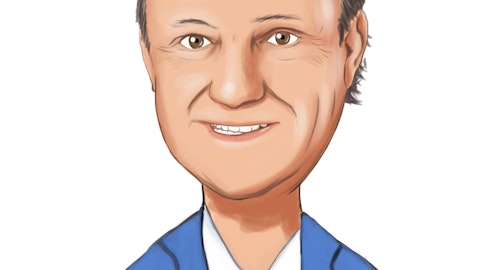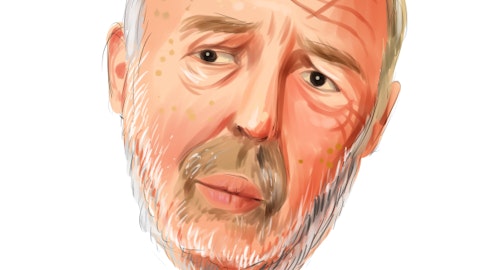Jeffery Hay: Thanks, Jeff. During the third quarter of 2023, we continued to navigate a challenging environment, facing both ongoing economic headwinds and an increased frequency of severe weather events. Our results for the quarter reflected a continuation of strategic initiatives to run off targeted underperforming accounts while selectively writing new accounts. We are continuing to push rate increases and numerous underwriting initiatives to improve the profitability of the overall business. While this effort is underway, we are actively positioning Donegal for future growth, particularly as market trends return to normal and we are achieving targeted profit levels. We intend to remain an active market participant for profitable new business with an intense focus on prudent risk selection and margin expansion as we utilize our advanced analytics to appropriately price risks and optimize our mix of business.
We have identified the most profitable opportunities from an industry, geographic, line of business and customer segment perspective with target mix percentages for each, and we are poised to grow in these profitable market segments as overall conditions improve. Commercial net written premiums decreased by approximately 2% during the quarter, reflecting in large part the non-renewal of commercial accounts located in Georgia and Alabama, as Kevin mentioned earlier, as well as other intentional actions by our frontline underwriters to move away from underperforming individual accounts and classes of business. Excluding the impact of our strategic non-renewal actions in Georgia and Alabama, commercial net premiums written increased approximately 7% in the quarter primarily due to significant increases in rate averaging nearly 13%, excluding workers’ compensation.
That’s coupled with strong retention and modest levels of conservatively underwritten new business premium. We will continue to emphasize property rate increases in the fourth quarter of 2023 and into 2024 as well as driving the highest rate levels in areas where the intersections of class, line of business, and geography are most challenging from a profit perspective. Our commercial lines’ statutory combined ratio was a 97.5% in the quarter, compared to 112.1% in the prior-year period, primarily driven by lower core losses and a significant decrease in large fire losses. Our core commercial loss ratio decreased 8.4 percentage points with improvements across all major lines of business, indicating that our rate and underwriting actions that have been underway for some time now are beginning to take effect.
The 49% reduction in large fire losses accounted for approximately a 5.5 percentage-point improvement in the commercial loss ratio. So, while our business will always have exposure to fire losses, we do have specific actions underway to perform an in-depth review of our large property portfolio to identify key fire risk factors and also to drive underlying improvements in our risk selection process to reduce the likelihood and frequency of large fire losses. Similar to what we have seen in announcements by others in our industry, we had a busy weather quarter from a claims perspective. An increase in frequency of smaller storms particularly affected the results of the commercial multi-peril line of business, as the weather-related loss ratio impact in that line increased to 17.5 percentage points compared to 9.7 points in the prior-year quarter.
The majority of the weather-related losses stemmed from local convective storm activity across our regions, with only nominal losses from Hurricanes Idalia and Ophelia, and the 2023 Derecho event in the Midwest. Our research and experience indicates not only an increase in the frequency of recent storm activity, but also an increase in the geographical areas that storms are now affecting. We have specific actions underway to manage our exposures and optimize our geographic spread of risk, identifying down to the county level where we want to grow or reduce commercial property exposures. As Kevin mentioned earlier, we have now completed our entire countrywide rollout of a new agency-facing portal with enhanced small commercial products, straight-through processing capabilities and online bindability that we believe will significantly improve our positioning within the small commercial market.
We consider ourselves a generalist carrier with a broad appetite for profitable accounts across a spectrum of industries, including contractors, retail, professional services and real estate, just to name a few. Early results are promising and feedback from our independent agents has been positive as we look to grow in the small commercial segment. Now turning to personal lines. Nearly 18% net premiums written growth in the third quarter reflected 14% average renewal rate increases and minimal exposure increases. Our actual numbers of policies in-force continues to remain close to flat year-over-year, indicating that the premium growth was almost entirely driven by rate achievement in the quarter. Rate increases averaged 11% for personal auto and almost 20% for homeowners.
As I stated in previous calls, we expect these percentages to continue to increase in the near term. Retention remained strong at 89% for the quarter, indicating that policyholders are accepting the higher renewal premiums with nearly every carrier in the market striving for rate increases to offset ongoing loss cost inflation trends. We continue to limit new business in personal lines, seeking to stabilize our profitability as our highest priority. The personal lines statutory combined ratio increased to 119.4%, compared to 107.8% for the prior-year period, primarily as a result of the same weather events I mentioned for our commercial lines of business that had a significant impact to our homeowners line, as Jeff Miller outlined in his earlier comments.
A key part of our strategy in personal lines is to diversify the geographic footprint of our property exposures to improve the loss ratio performance of the homeowners line of business. We have identified, down to the county level, where we are looking to grow and where we need to reduce exposures in order to optimize our risk profile for the property line. We have already made a beneficial shift in our exposures, as policies in force are growing modestly in targeted profitable counties and shrinking in counties identified for profit improvement. Now, at this time, I’d like to turn it over to Tony Viozzi for an update on our investment portfolio. Tony?



